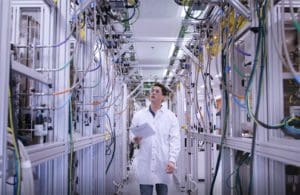
A GSK vaccine facility. Image courtesy of GSK.
Digital twins, functional computerized models of physical objects, are a staple of smart manufacturing. Their use in the pharmaceutical industry, however, is still in an early phase.
GlaxoSmithKline (LON:GSK) is one of the first pharmaceutical companies to announce a digital twin initiative. Partnering with Siemens (ETR:SIE) and Atos (EPA:ATO), GSK has created a real-time simulation of the entire vaccine manufacturing process.
A year in the making
The project, which launched a year ago, has already shown promise in reducing manufacturing timelines, optimizing product quality and other areas. The use of digital twins has enabled GSK to optimize vaccine-related experiments. “With digital twins, you’re able to do huge amounts of digital experiments and minimize the number of wet experiments that you do,” said Matt Harrison, head of sciences, digital innovation and business strategy at GSK Vaccines. Digital twin–based experiments also can eliminate the need to build a test facility, which can potentially take years. “We can run multiple experiments — modeling and simulating — rather than going to a laboratory,” Harrison said.
[Related: Pharma’s been slow to adopt Industry 4.0 — but that could change]
Additionally, the technology enables an improved understanding of the factors that impact the variability of the manufacture of vaccines’ components such as adjuvant particles. “Combining digital experimentation with wet experimentation really helps,” Harrison said. “That has definitely accelerated the development process here.”
Digital twins can also help vaccine manufacturers like GSK understand the array of factors that can impact adjuvant particles.
Why digital twins both demand and promote agility
GSK plans on using the technology for all of its future vaccines and some of its discovery activities. The initial thrust for the digital twin proof-of-concept was to find a concrete benefit for the technology and scale it. “We’ve tried to keep it small and agile to start with,” Harrison said.
Harrison said that a guiding vision for the project helped keep the digital twin initiative on track during a pandemic while also reducing the number of setbacks along the way. “When you go into something with an exploratory mindset, you’re prepared to fail a little bit,’ he said. “Any science-based innovation-based organization is used to trying things, learning from failing and moving on.”
Harrison underscores the importance of having a clear sense of what data are required before building digital twins. The company worked with its partners and data science teams to identify the data and models needed for the digital twins. “And then, we were able to go build those models, and then ultimately start testing,” Harrison said. “A key thing here has been a blend of digital experimentation and physical experimentation — going and actually doing stuff and seeing what happens.”
GSK used an agile methodology to help it identify priorities for each step along the way.
Fundamentally, vaccine discovery and development have relied heavily on experimentation to formulate optimal experimental vaccines to supply clinical trials. Digital twins can accelerate that process, starting with the early phases of discovery and development.
“The earlier you can build your product understanding, the better,” Harrison said. Using AI models can optimize candidate selection decisions based on manufacturability and other factors.
There remains significant potential for digital twins throughout the pharmaceutical industry, according to Harrison. “I think our industry is in that ‘proving it’ phase,” he said. “From a GSK perspective, our vision is to understand how we can utilize this [digital twin] technology.” Given that GSK has multiple vaccine platforms, the firm has considerable opportunities for future experimentation. “We see some real opportunities here,” Harrison concluded.
Filed Under: Drug Discovery, Industry 4.0





Tell Us What You Think!
You must be logged in to post a comment.